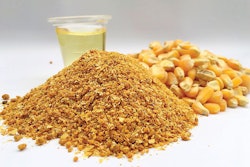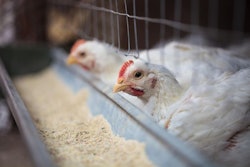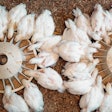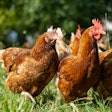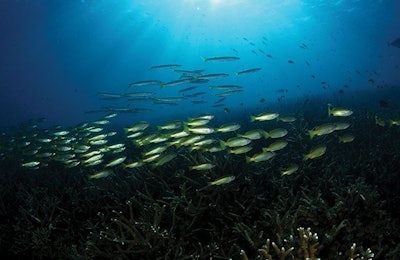
Once upon a time, good quality fish meal was US$500 per imperial ton, or thereabouts, and everyone was using it. Poultry diets invariably contained 5 percent fish meal, with early broiler feeds and layer diets having as much as 10 percent. What prevented most nutritionists from using even more fish meal in poultry diets was not cost, but its concentration in fish oil.
With 10 percent oil, adding 10 percent fish meal in any diet gives 1 percent fish oil, which is the maximum poultry will tolerate before they start rejecting feed or producing eggs with "fishy" aroma. In fact, it was not so much the fishy aroma of feeds that caused broilers go off feed easily but rather the rapidity with which fish oil became rancid — and stale fish oil really stinks! But, again, fish meal was an indispensable ingredient in poultry diets, to the point most nutritionists claimed the so called "factor-X," or unknown nutrient in fish meal, that was yet to be identified — perhaps they were right, but we will never find out now.
Why fish meal was so popular?
Fish meal was so popular because the ratio of price to nutritive value was exceptional. At a price that today is closer to full-fat soybeans, fish meal offered double (almost) the protein, a better amino acid profile and a boost in feed intake that was not to be found in other ingredients. When feed intake, for any reason, was a problem, nutritionists always considered increasing the concentration of fish meal. In fact, one of the ingredients that helped in the transition to antibiotic-free feeds was fish meal, used in levels reaching sometimes up to 15 percent. But, back then, fish meal was always of good quality and always inexpensive — in other words, good quality fish meal was readily available. Not that lower quality fish meal was not there, but it was used in other outlets, or in older animals.
The present
Today, good quality fish meal costs from US$1,500 to US$2,000 dollars per imperial ton. The actual price is not important — as there is nothing we can do about it — but the magnitude of increase is staggering: three to four times more expensive. The reasons are many, and it suffices to say that aquafeeds and pet foods on one hand, with over-fishing on the other hand, have caused an increase in demand and decrease in offer — the perfect combination for prices to raise in previously unimaginable levels. Again, we shall not consider the lower quality fish meals, because their many problems — in the form of increased risks — are too many to consider in sensitive diets such as those offered to rapidly growing birds and layers producing eggs for human consumption. With such high cost, good quality fish meal has become a luxury ingredient in poultry diets, and many consider whether they should accept the high price or just ignore this ingredient.
Using fish meal has become a tool to overcome problems rather than a dependable source of proteins.
Pros
Fish meal remains an excellent source of protein, and if it is of the best quality, it will still improve feed intake. This remains an undeniable fact that has not changed. Thus, when one is faced with animals suffering from low feed intake problems, or wants to supplement a protein source of exceptionally low quality (and cost), then using fish meal remains a good option. In all likelihood, such an option will pay for itself and is recommended. Perhaps it is not feasible to use fish meal in all poultry diets and, as such, its use should be limited to super sensitive diets, such as those destined for broilers in the first days post-hatch (super pre-starter diets), when birds recover from a gut damaging disease or when feed intake is hampered by a bitter or other undesirable ingredient. In brief, using fish meal has become a tool to overcome problems rather than a dependable source of proteins.
Cons
Against fish meal are numerous reports about its quality (mostly rancidity but also putrefaction of proteins due to improper storage of fish before processing into fish meal). One also has to consider the social/environmental image or impact when using an ingredient that is depleting wild stocks of fish, but such scruples also affect those industries that use up current quantities of fish meal without much regard to its cost. Reports that fish meal spread diseases, such as Salmonella, are not new or novel. Any animal or otherwise ingredient can become a carrier of disease microorganisms, and excluding one or the other has not stopped diseases from spreading. It is lack of proper quality control and not specific ingredients that cause this kind of problem — as it has repeatedly been demonstrated.
Read more: 5 guidelines for alternative animal feed ingredients
The future
Wild stocks of fish suitable for fish meal do not appear to recover, at least not as fast as would enable prices to drop back to historical levels. If aquafeeds reduce their dependence on fish meal to feed carnivorous farmed fish, then perhaps we can enjoy some decrease in prices, but this remains a rather remote possibility as well. Thus, traditional fish meal will remain expensive in the foreseeable future unless we have a revolutionary turn of events. What is most promising is the conversion of fish waste into fish meal. The potential is huge; the quantities are available, but the investment is equally daunting, and the word waste is not only deceptive, but also misleading. Fish meal from waste parts can be of even higher quality than fish meal from fished stock, but that is a totally different story.



